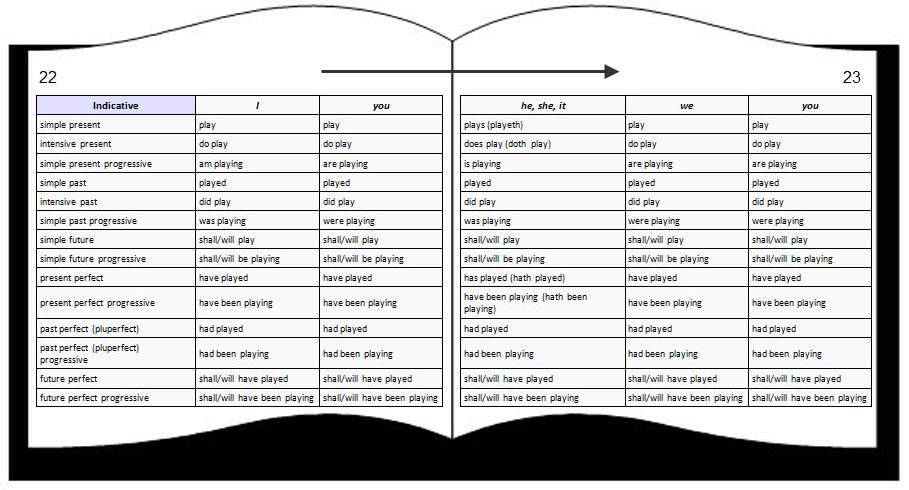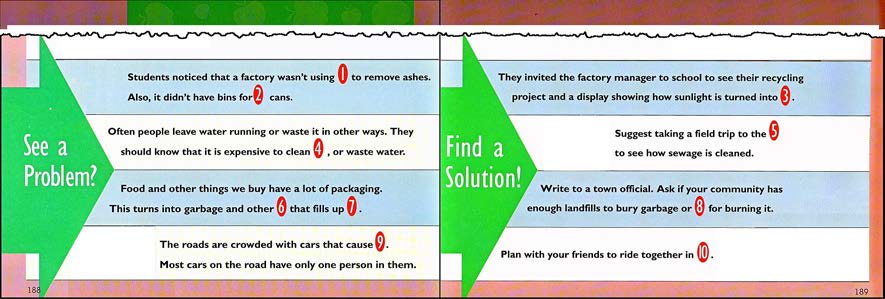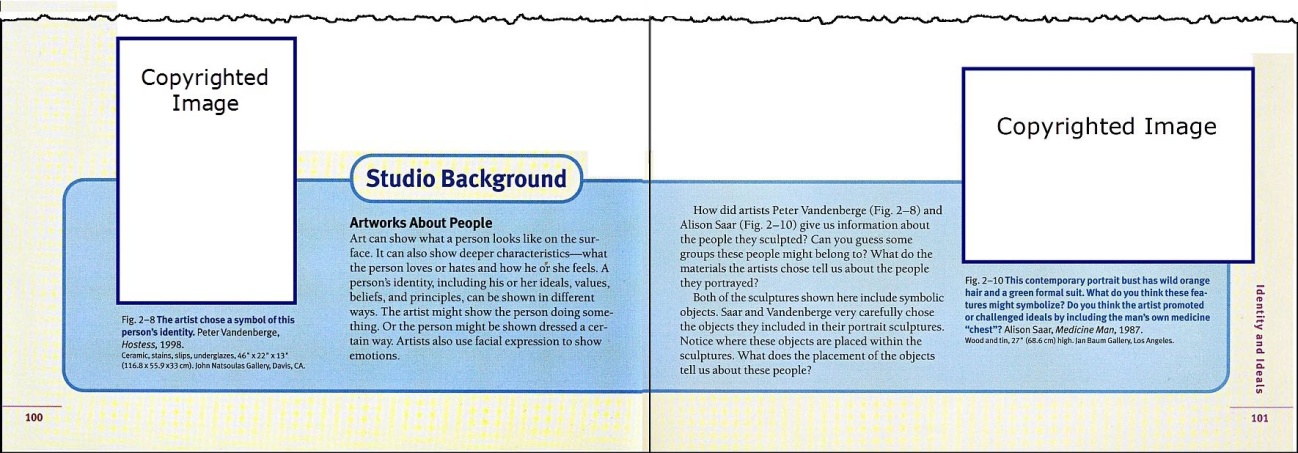Section 7
Boxed Material
7.1 Fundamentals
7.2 Blank Lines
7.3 Boxes
7.4 Boxed Material Continued on Another Print Page
7.5 The Relationship Between Text and Boxes on Facing Print Pages
7.6 Different Colored Boxes
7.7 Boxes within Boxes
7.8 Samples
7.1.1 The provisions of this section apply to materials printed inside boxes, or screened materials shown by the use of colors or shaded backgrounds. Both boxes and screened materials are referred to as "boxed material" throughout this section.
7.1.2 Box lines are used always when text references material as being in a box. Using box lines in other situations is at the transcriber's discretion. If the content doesn't fit well into the flow of text, it's best to retain the box lines.
7.1.3 Box Lines
7 (2356) Top box line
g Bottom box line
= Top and bottom exterior borders for a set of nested boxes
7.1.4 Special Symbols and Transcriber's Notes
Special Symbols
- Color symbols for colored boxes
- Box lines
Transcriber's Notes
- Identify the page number where content will continue after full-page box interrupts the flow of text
- Identify the page number where content is continued from after a full-page box interrupts the flow of text
- Box location on facing pages
- Use of color indicators to identify box color
- Supporting information for multiple boxes within a box
7.1.5 A Braille Reader's Perspective
A blank line before and after a box helps a reader quickly distinguish a top box line from a bottom box line, especially when boxes are longer than a braille page.
If two separate boxes follow each other, as opposed to appearing as a smaller box in a bigger box, a blank line between boxes helps a braille reader know the difference.
7.2.1 Boxes are preceded and followed by blank lines.
a. A top box line can appear on line 1 when a running head is not used and line 3 when a running head is used.
b. A blank line separates a page change indicator from a box line.
c. A blank line cannot follow a top box line.
d. A blank line cannot precede a bottom box line.
Exceptions:
e. Blank lines do not separate boxed material from accompanying headings, captions, or source citations.
f. Interior box lines do not have blank lines before or after the box line.
g. A related heading can precede a box, in which case there is no blank line between the heading and top box line.
h. Do not insert a blank line between a bottom box line and source information related to the box.
i. See §7.7.1 for use of blank lines for boxes within boxes.
7.3.1 Placement of Boxes. Boxed material is inserted at the most logical place on the print page where the box occurs. It is preferable that boxed material be placed on a single braille page.
7.3.2 Each box begins with a top box line and ends with a bottom box line, regardless of the number of braille pages required for the box.
7.3.3 The top and bottom box lines start at the left margin and extend across the full width of the braille page, regardless of the width of the print box. The width of the braille page is dependent upon the format of the material being transcribed.
a. Box lines on the first or last line of a braille page are separated from the page number by at least three blank cells.
b. The length of box lines within line-numbered text adheres to the required two blank cells before line numbers.
Example 7-1: Box within Line-Numbered Prose

|
ga9$1 & write !m \ = public,n4 ,&⠀⠀⠀⠀#hj
he a4$3
⠀⠀⠀⠀⠀⠀⠀⠀⠀⠀⠀⠀⠀⠀⠀⠀⠀⠀⠀⠀⠀⠀⠀⠀⠀⠀⠀⠀⠀⠀⠀⠀⠀⠀⠀⠀⠀⠀⠀⠀
77777777777777777777777777777777777⠀⠀⠀⠀⠀
8,n"e say ,8,we le>n0' s-&-s1 or⠀⠀⠀⠀⠀#ha
,8,x is report$10' or ,8,x is
rumor$10' or ,8,we "u/&0' '''⠀⠀⠀⠀⠀⠀⠀⠀#hb |
7.3.4 Left and right box lines are not used.
Example 7-2: Boxed Columns

|
⠀⠀⠀⠀⠀⠀⠀⠀⠀⠀⠀⠀⠀⠀⠀⠀⠀⠀⠀⠀⠀⠀⠀⠀⠀⠀⠀⠀⠀⠀⠀⠀⠀⠀⠀⠀⠀⠀⠀⠀
7777777777777777777777777777777777777777
⠀⠀⠀⠀⠀⠀⠀⠀⠀⠀⠀⠀⠀⠀⠀,=ms ( .2
⠀⠀⠀⠀⠀⠀⠀⠀⠀⠀⠀⠀⠀⠀⠀⠀⠀⠀⠀⠀⠀⠀⠀⠀⠀⠀⠀⠀⠀⠀⠀⠀⠀⠀⠀⠀⠀⠀⠀⠀
,s+ul> ,plural
"3333333333 "3333333333
is 7pres5t7 >e 7pres5t7
0 7pa/7 """ 7 7pa/7
gggggggggggggggggggggggggggggggggggggggg
⠀⠀⠀⠀⠀⠀⠀⠀⠀⠀⠀⠀⠀⠀⠀⠀⠀⠀⠀⠀⠀⠀⠀⠀⠀⠀⠀⠀⠀⠀⠀⠀⠀⠀⠀⠀⠀⠀⠀⠀ |
7.3.5 Dividing Boxes Between Braille Pages
a. A top box line must be followed by at least one line of text on the braille page. If the box line is followed by a heading, the heading must be followed by at least one line of text.
b. A bottom box line must be preceded by at least one line of text on the braille page.
7.3.6 Full Print Page(s) of Boxed Material
a. When the body of text is interrupted by a full print page or more of boxed material, insert a transcriber's note before the page change indicator, informing the reader where text is continued, using print page numbers. Sample:
Text continues on page 45.
b. Insert a transcriber's note before resuming text, usually after a page change indicator, informing the reader where the text was interrupted. Include the continuation letter with the print page number. Sample:
Text continued from page c43.
7.3.7 Wide Boxes Shown Side by Side. If several boxes are shown in a row across a print page, they are presented vertically as separate boxes in braille.
7.3.8 Adjoining Vertical Boxes. Close the first box before opening a second box. Insert a blank line between each box.
See Sample 7-1: Two Boxes Separated by a Blank Line starting on page 7-10.
7.4 Boxed Material Continued on Another Print Page
7.4.1 Boxes may require several braille pages.
a. The boxed material is placed in a logical location on the braille page where it fits within the flow of the text, e.g., at the end of the paragraph where the box is introduced.
b. Marginal boxed materials without a text anchor are placed at the end of the last paragraph on the print page.
c. A box should be completed on one braille page if possible. For tabular material, see Section 11, Tables and Related Columns.
7.5.1 There are four possible situations:
a. A single box shown across facing print pages, and read across as if on a single page, is transcribed as a single box. No other text is on either page. Use combined page numbers, e.g., 22-23, a22-23, etc. Box lines may be omitted if the content will fit on a single braille page without them. Option: Tables printed across print facing pages may be produced as braille facing pages, if all the material will fit on the two pages. See Section 11, Tables and Related Columns, §11.13, Wide Tables: Facing Pages.
Example 7-3: Box Read Across Pages (Print)

b. Full page boxes on adjoining pages, and read as two separate boxes, are transcribed as separate boxes. Retain the box lines to convey the change in context. Individual page numbers are used, e.g., 44, a44, 45, a45, etc.
c. A box read across facing pages, with other text outside the box, is placed at the most logical place on one of the two pages. Insert a transcriber's note before the box, informing the reader of the location. Sample:
The following box appears across the bottom of pages 100-101.
Example 7-4: Box Read Across Pages (Print)

d. A box designed to be read on the left page and continue on the next page needs to remain intact. Transcribe the text on the first page, then the boxed material. Insert the page change indicator, and complete the boxed material before returning to the remainder of the text. Note, if the box breaks the flow of text on the first page, e.g., mid-paragraph, insert the box at the most appropriate location and include a transcriber's note, as in the previous example.
Example 7-5: Box Across Facing Pages (Print)

See Section 5, Font Attributes, §5.6, Colored Fonts for information about color indicators.
7.6.1 Books may use boxes in various colors, also called screened materials, to distinguish types of content. Indicate the box color unless all the boxes are the same color. The book may not reference the color, but it is possible a corresponding workbook will make note of it, or colors may identify the level of activity difficulty, or a teacher may reference the box color for study purposes, etc.
7.6.2 The top box line begins with the color indicator in cell 1, followed by a blank cell, before filling the remainder of the line. A termination indicator is not used. Explain this usage on the Transcriber's Notes page. The color symbols are listed on the Special Symbols page.
See Sample 7-2: Screened Word Lists starting on page 7-12.
7.7.1 One or more boxes within a box are transcribed in a different manner than regular boxes. Include a transcriber's note explaining how the boxes are related if necessary.
= Top and bottom exterior borders
7 (2356) Top interior box line
g Bottom interior box line
a. Do not insert a blank line between a top exterior border and a top interior box line.
b. Do not insert a blank line between a bottom interior box line and a bottom exterior border.
c. Insert a blank line before a top interior box line when it begins on any line other than immediately after the top exterior border.
d. Insert a blank line after a bottom interior box line when it ends on any line other than immediately before the bottom exterior border.
e. Consecutive interior boxes are opened and closed with top and bottom interior box lines.
f. Consecutive box lines between interior boxes are separated by a blank line.
See Sample 7-3: Box Within a Box starting on page 7-14.
7.8 Samples
Sample 7-1: Two Boxes Separated by a Blank Line, page
7-10
Sample 7-2: Screened Word Lists, page 7-12
Sample 7-3: Box Within a Box, page 7-14




